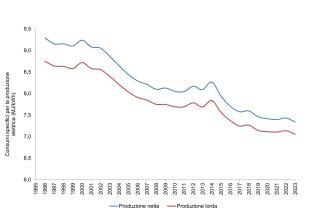Panel 1
Antonio Caputo
The indicator measures the primary energy, expressed in MJ, required to produce one kWh of electricity, or more precisely, it reflects the efficiency of converting primary energy from fossil fuel sources into electricity for final consumption. Available data highlight a reduction in specific energy consumption related to electricity production of 18.4% for gross production and 20% for net production between 1996 and 2022. The long-term trend of the indicator therefore shows an improvement in the electricity generation efficiency of the thermoelectric power plants.
The indicator measures the primary energy, expressed in MJ, required to produce one kWh of electricity.
To evaluate the efficiency of converting primary energy from fossil fuel sources into electricity for final consumption.
Not applicable
Panel 2
TERNA S.p.A., Statistical Data on Electric Energy in Italy, various years
The average data are significant only at the national level due to the heterogeneity of plant types and fuels used.
Data quality assessment
Terna - Rete Elettrica Nazionale S.p.A.
Retrieval of the documents "Statistical Data on Electric Energy in Italy, various years" from the website https://www.terna.it/en/electric-system/statistics/statistical-publications
National
1996-2022
Indicator assessment
The data are collected and processed directly by TERNA.
The specific fuel consumption for gross electricity generation in 2022 was 7.14 MJ/kWh, while for net generation it was 7.43 MJ/kWh. Compared to the previous year, the 2022 specific consumption figures show an increase of 0.5% for both gross and net electricity generation (Tables 1 and 2).
The available data highlight a reduction in specific energy consumption for electricity generation of 18.4% for gross production and 20% for net production between 1996 and 2022 (Figure 1). The long-term trend of the indicator shows a steady increase in the efficiency of electricity generation from the thermoelectric fleet up to 2008, after which it appears to stabilize. Following a spike in average specific consumption in 2014, a significant decrease has been observed in recent years, reaching in 2021 the lowest value recorded so far, followed by a slight increase in 2022.
Data
Table 1: Average specific fuel consumption in gross electricity generation from fossil sources(a)
TERNA S.p.A.
(a) Gross electricity production refers to the total amount of electricity generated, measured at the generator terminals.
Table 2: Average Specific Fuel Consumption in Net Electricity Generation from Fossil Sources(a)
TERNA S.p.A.
(a) Net electricity production refers to the total amount of electricity generated, measured at the output of the production plants.

The downward trend in specific energy consumption for electricity generation can be attributed to the progressive commissioning of combined cycle power plants—fueled by natural gas or derived gases—which offer higher efficiency compared to conventional plants. Furthermore, the new-generation combined cycle units exhibit greater efficiency than those commissioned in earlier phases. In contrast to this general trend, an increase in the specific consumption of solid fuels used for electricity generation has been observed, primarily due to the additional energy demand of emission control systems commissioned between 1999 and 2000 (Figure 1). The specific consumption of solid fuels for gross electricity production shows an increasing trend from 1999 to 2008, followed by a steady decrease until 2012, and a subsequent fluctuating pattern that becomes consistently upward from 2017, peaking in 2021 at the highest value in the time series (Table 1). In 2022, the specific consumption of solid fuels for gross electricity production increased by 6.9% compared to 2011. Natural gas, on the other hand, shows a significant decrease in specific consumption, with a 21.3% reduction recorded in 2022 relative to 2001. Over the same period, other solid fuels (excluding coal) exhibit a 20.1% increase in specific consumption. Notably, there is a consistent decline in the specific consumption of other gaseous fuels, amounting to a 19.7% decrease.